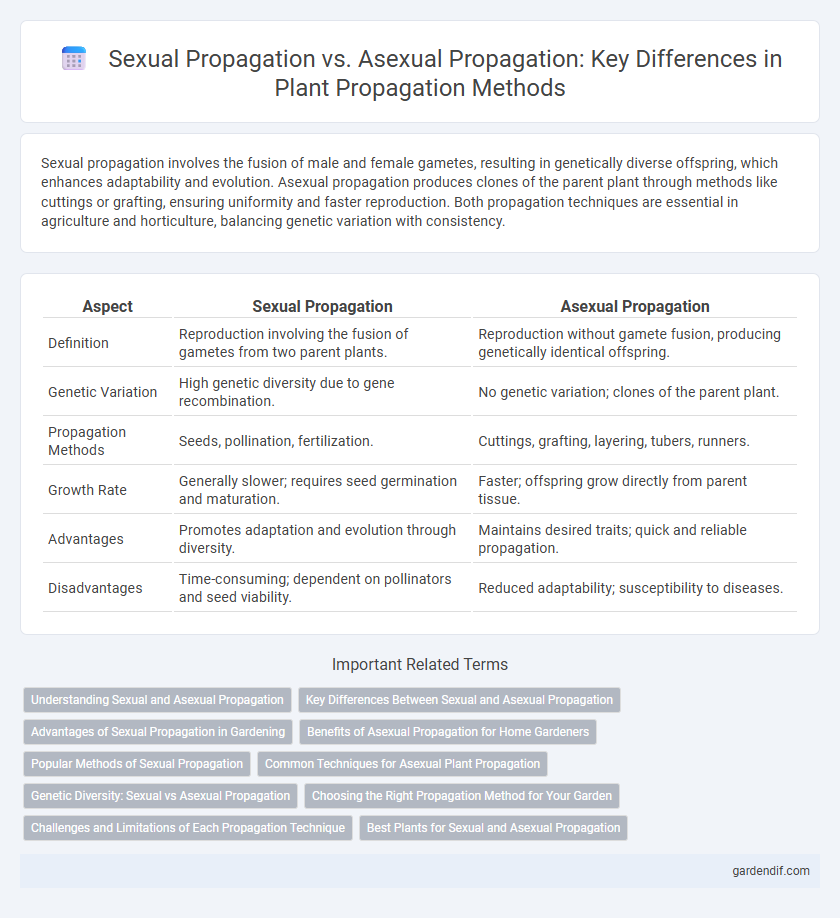
Sexual propagation vs Asexual propagation Illustration
Sexual propagation involves the fusion of male and female gametes, resulting in genetically diverse offspring, which enhances adaptability and evolution. Asexual propagation produces clones of the parent plant through methods like cuttings or grafting, ensuring uniformity and faster reproduction. Both propagation techniques are essential in agriculture and horticulture, balancing genetic variation with consistency.
Table of Comparison
| Aspect | Sexual Propagation | Asexual Propagation |
|---|---|---|
| Definition | Reproduction involving the fusion of gametes from two parent plants. | Reproduction without gamete fusion, producing genetically identical offspring. |
| Genetic Variation | High genetic diversity due to gene recombination. | No genetic variation; clones of the parent plant. |
| Propagation Methods | Seeds, pollination, fertilization. | Cuttings, grafting, layering, tubers, runners. |
| Growth Rate | Generally slower; requires seed germination and maturation. | Faster; offspring grow directly from parent tissue. |
| Advantages | Promotes adaptation and evolution through diversity. | Maintains desired traits; quick and reliable propagation. |
| Disadvantages | Time-consuming; dependent on pollinators and seed viability. | Reduced adaptability; susceptibility to diseases. |
Understanding Sexual and Asexual Propagation
Sexual propagation involves the fusion of male and female gametes, resulting in genetically diverse offspring, which enhances adaptability and evolution. Asexual propagation produces genetically identical clones through methods like cuttings, layering, or tissue culture, offering rapid multiplication and uniformity. Understanding these propagation types helps optimize plant breeding, conservation, and horticultural practices by balancing genetic variation with propagation efficiency.
Key Differences Between Sexual and Asexual Propagation
Sexual propagation involves the fusion of male and female gametes, resulting in genetic variation among offspring, while asexual propagation produces genetically identical clones from a single parent without gamete fusion. Sexual propagation typically requires more time and resources due to pollination and seed development, whereas asexual propagation offers rapid multiplication through methods like cuttings, grafting, or tissue culture. The choice between these propagation types depends on the desired genetic diversity, speed of reproduction, and crop uniformity.
Advantages of Sexual Propagation in Gardening
Sexual propagation in gardening enhances genetic diversity, leading to healthier plants with improved resistance to diseases and environmental stress. It allows for the creation of new plant varieties with desirable traits, supporting biodiversity and adaptation. This method also promotes robust root and shoot systems, contributing to overall plant vigor and productivity.
Benefits of Asexual Propagation for Home Gardeners
Asexual propagation offers home gardeners rapid plant multiplication by producing genetically identical offspring, ensuring consistent traits and quality. It requires less skill and reduces variability, making it ideal for preserving rare or favored plant varieties. This method also allows for year-round propagation without the need for seeds, enhancing crop reliability and garden productivity.
Popular Methods of Sexual Propagation
Popular methods of sexual propagation include seed sowing, which ensures genetic diversity and adaptability in plants. Techniques like cross-pollination and controlled hybridization optimize fruit yield and resistance to diseases. Sexual propagation is widely used in crops such as tomatoes, apples, and maize due to its efficiency in producing robust offspring.
Common Techniques for Asexual Plant Propagation
Common techniques for asexual plant propagation include cuttings, layering, division, and grafting, which allow plants to reproduce genetically identical offspring without the need for seeds. Cuttings involve rooting a portion of a stem, leaf, or root, while layering encourages roots to form on a stem still attached to the parent plant. Grafting combines tissues from two plants to grow as one, enhancing desirable traits and disease resistance.
Genetic Diversity: Sexual vs Asexual Propagation
Sexual propagation generates offspring with genetic variation due to the combination of genetic material from two parent plants, enhancing adaptability and resilience within a population. Asexual propagation produces genetically identical clones, preserving desirable traits but limiting genetic diversity and potential adaptability to environmental changes. This distinction significantly impacts plant breeding strategies and conservation efforts, emphasizing the role of genetic diversity in ecosystem stability.
Choosing the Right Propagation Method for Your Garden
Sexual propagation, involving seed germination, promotes genetic diversity and resilience in plants, ideal for breeding new varieties or enhancing adaptability. Asexual propagation, such as cuttings or grafting, ensures clones of the parent plant, preserving desired traits and accelerating growth for uniform garden results. Selecting the right method depends on plant species, desired genetic variation, growth speed, and maintaining specific characteristics in your garden.
Challenges and Limitations of Each Propagation Technique
Sexual propagation faces challenges such as genetic variability, leading to inconsistent offspring traits and longer time to maturity, which can impact crop uniformity and productivity. Asexual propagation, while ensuring genetic uniformity and faster establishment, encounters limitations like susceptibility to diseases and a reduced gene pool that may affect resilience and adaptability. Both techniques require careful selection based on species-specific traits and desired outcomes to optimize plant quality and yield.
Best Plants for Sexual and Asexual Propagation
Sexual propagation is ideal for plants like tomatoes, peppers, and marigolds, which produce viable seeds that encourage genetic diversity and robustness. Asexual propagation suits plants such as roses, potatoes, and succulents, where cuttings, tubers, or leaf sprouts create genetically identical offspring with rapid growth. Understanding the best plants for each method enhances crop yield, disease resistance, and garden uniformity.
Sexual propagation vs Asexual propagation Infographic

 gardendif.com
gardendif.com